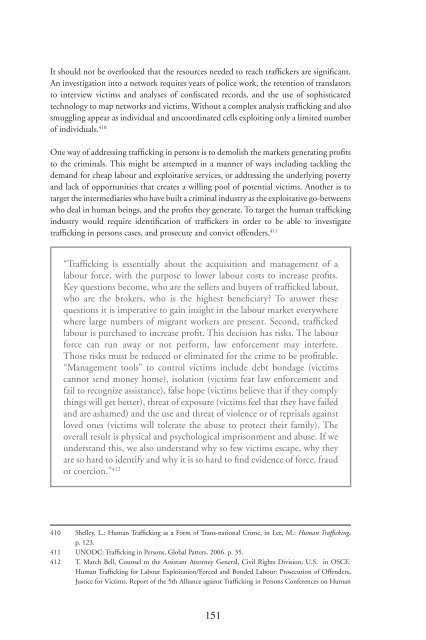Trafficking in human beings: human rights and ... - unesdoc - Unesco
Trafficking in human beings: human rights and ... - unesdoc - Unesco
Trafficking in human beings: human rights and ... - unesdoc - Unesco
You also want an ePaper? Increase the reach of your titles
YUMPU automatically turns print PDFs into web optimized ePapers that Google loves.
It should not be overlooked that the resources needed to reach traffi ckers are signifi cant.<br />
An <strong>in</strong>vestigation <strong>in</strong>to a network requires years of police work, the retention of translators<br />
to <strong>in</strong>terview victims <strong>and</strong> analyses of confi scated records, <strong>and</strong> the use of sophisticated<br />
technology to map networks <strong>and</strong> victims. Without a complex analysis traffi ck<strong>in</strong>g <strong>and</strong> also<br />
smuggl<strong>in</strong>g appear as <strong>in</strong>dividual <strong>and</strong> uncoord<strong>in</strong>ated cells exploit<strong>in</strong>g only a limited number<br />
of <strong>in</strong>dividuals. 410<br />
One way of address<strong>in</strong>g traffi ck<strong>in</strong>g <strong>in</strong> persons is to demolish the markets generat<strong>in</strong>g profi ts<br />
to the crim<strong>in</strong>als. This might be attempted <strong>in</strong> a manner of ways <strong>in</strong>clud<strong>in</strong>g tackl<strong>in</strong>g the<br />
dem<strong>and</strong> for cheap labour <strong>and</strong> exploitative services, or address<strong>in</strong>g the underly<strong>in</strong>g poverty<br />
<strong>and</strong> lack of opportunities that creates a will<strong>in</strong>g pool of potential victims. Another is to<br />
target the <strong>in</strong>termediaries who have built a crim<strong>in</strong>al <strong>in</strong>dustry as the exploitative go-betweens<br />
who deal <strong>in</strong> <strong>human</strong> be<strong>in</strong>gs, <strong>and</strong> the profi ts they generate. To target the <strong>human</strong> traffi ck<strong>in</strong>g<br />
<strong>in</strong>dustry would require identifi cation of traffi ckers <strong>in</strong> order to be able to <strong>in</strong>vestigate<br />
traffi ck<strong>in</strong>g <strong>in</strong> persons cases, <strong>and</strong> prosecute <strong>and</strong> convict offenders. 411<br />
412<br />
“Traffi ck<strong>in</strong>g is essentially about the acquisition <strong>and</strong> management of a<br />
labour force, with the purpose to lower labour costs to <strong>in</strong>crease profi ts.<br />
Key questions become, who are the sellers <strong>and</strong> buyers of traffi cked labour,<br />
who are the brokers, who is the highest benefi ciary? To answer these<br />
questions it is imperative to ga<strong>in</strong> <strong>in</strong>sight <strong>in</strong> the labour market everywhere<br />
where large numbers of migrant workers are present. Second, traffi cked<br />
labour is purchased to <strong>in</strong>crease profi t. This decision has risks. The labour<br />
force can run away or not perform, law enforcement may <strong>in</strong>terfere.<br />
Those risks must be reduced or elim<strong>in</strong>ated for the crime to be profi table.<br />
“Management tools” to control victims <strong>in</strong>clude debt bondage (victims<br />
cannot send money home), isolation (victims fear law enforcement <strong>and</strong><br />
fail to recognize assistance), false hope (victims believe that if they comply<br />
th<strong>in</strong>gs will get better), threat of exposure (victims feel that they have failed<br />
<strong>and</strong> are ashamed) <strong>and</strong> the use <strong>and</strong> threat of violence or of reprisals aga<strong>in</strong>st<br />
loved ones (victims will tolerate the abuse to protect their family). The<br />
overall result is physical <strong>and</strong> psychological imprisonment <strong>and</strong> abuse. If we<br />
underst<strong>and</strong> this, we also underst<strong>and</strong> why so few victims escape, why they<br />
are so hard to identify <strong>and</strong> why it is so hard to fi nd evidence of force, fraud<br />
or coercion.” 412<br />
410 Shelley, L.: Human Traffi ck<strong>in</strong>g as a Form of Trans-national Crime, <strong>in</strong> Lee, M.: Human Traffi ck<strong>in</strong>g,<br />
p. 123.<br />
411 UNODC: Traffi ck<strong>in</strong>g <strong>in</strong> Persons, Global Patters. 2006. p. 35.<br />
412 T. March Bell, Counsel to the Assistant Attorney General, Civil Rights Division, U.S. <strong>in</strong> OSCE:<br />
Human Traffi ck<strong>in</strong>g for Labour Exploitation/Forced <strong>and</strong> Bonded Labour: Prosecution of Offenders,<br />
Justice for Victims. Report of the 5th Alliance aga<strong>in</strong>st Traffi ck<strong>in</strong>g <strong>in</strong> Persons Conferences on Human<br />
151

















